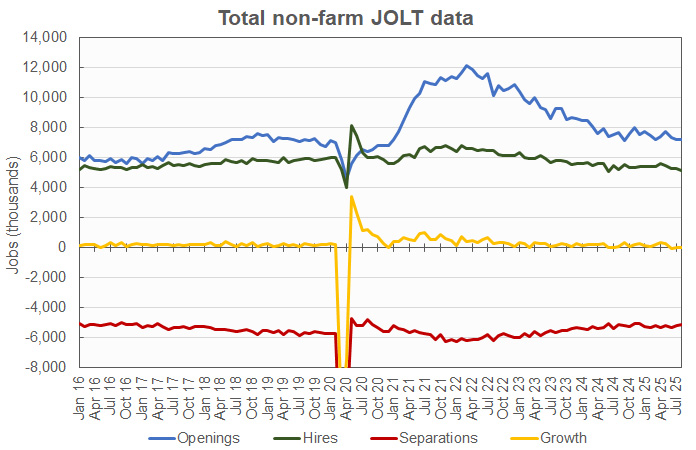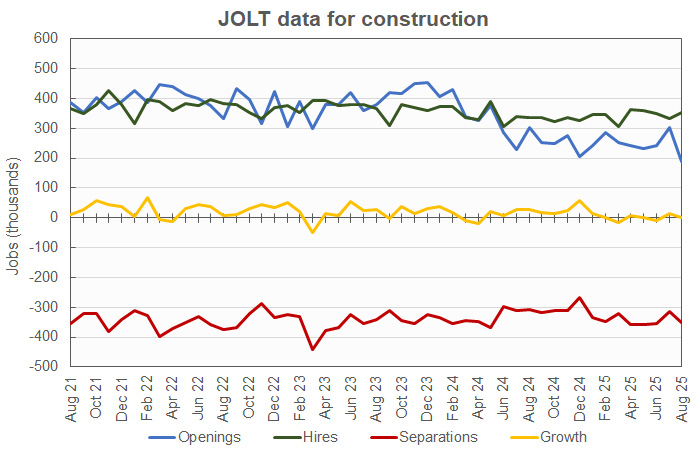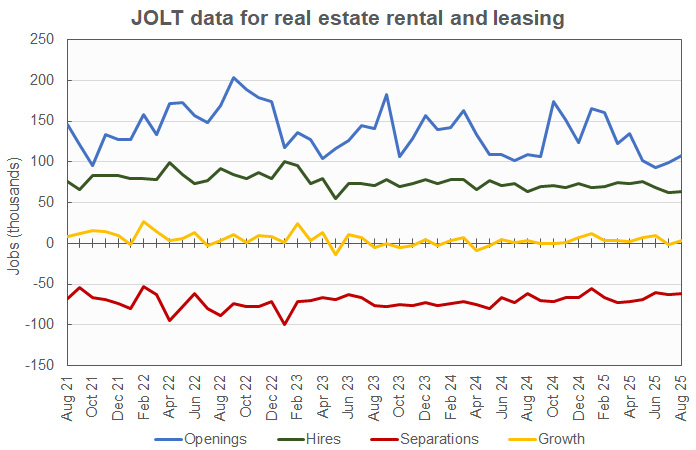The Job Openings and Labor Turnover (JOLT) report from the Bureau of Labor Statistics (BLS) said that the number of total non-farm job openings in August rose to 7.23 million. However, minimal employment growth was reported for the economy as-a-whole and for both construction and for real estate and renting and leasing.
Fewer openings but more hiring
Job openings were reported to be up 19,000 openings month-over-month. In addition, the openings figure for July was revised higher by 27,000 openings, so the August openings figure is 46,000 higher than the initial level reported for July last month. Total job openings are down 422,000 from their year-ago level.
Hiring was reported to be down by 114,000 jobs from last month’s revised (-68,000) figure for the economy as a whole, falling to a level of 5.13 million hires.
Total separations fell 110,000 from last month’s revised (-68,000) figure to a level of 5.11 million. Within total separations, quits were reported to fall by 75,000 jobs while layoffs fell by 62,000 jobs. Quits represented 60.5 percent of total separations for the month, slightly below the trailing 12-month average of 61.1 percent.
Total non-farm JOLT data since January 2016 is shown in the first chart, below.

The August job openings figure represents 4.3 percent of total employment plus job openings. For comparison, the unemployment rate in August was reported to be 4.32 percent and 7.38 million people were unemployed. Another 6.50 million people said that they would like a job but were not counted as being in the labor force since they were not actively seeking employment.
For a discussion of the JOLT report and how it relates to the Employment Situation Report, please see the paragraph at the end of this article.
The excess of hiring over separations in the August JOLT report implies an employment increase of only 15,000 jobs for the month. While revisions were made to both last month’s hiring and separations figures, the resulting net employment growth for last month was unchanged at 19,000 jobs.
Of those leaving their jobs in August, 3.09 million quit voluntarily, while 1.73 million people were involuntarily separated from their jobs. The remainder of people leaving their jobs left for other reasons, such as retirements or transfers. The portion of people quitting their jobs fell slightly from last month’s figure to 1.9 percent of the labor force. The involuntary separations rate was unchanged from last month’s figure at 1.1 percent.
Construction job growth stalls as openings plummet
The next chart, below, shows the employment situation for the construction jobs market over the last 49 months. It shows that August saw a net gain of only 2,000 construction jobs. In addition, last month’s preliminary gain of 24,000 construction jobs was revised lower to a gain of 15,000 jobs.

The preliminary construction job openings figure for August was reported to be down by 115,000 openings from last month’s revised (-3,000) figure to 188,000 openings. This is the lowest number of construction jobs openings reported since May 2017. Openings were reported to be down 38.2 percent from last year’s level and were reported to represent only 2.2 percent of construction employment plus job openings.
Hiring was reported to be up by 22,000 jobs in August from the prior month’s revised (-11,000) jobs figure to 353,000 new hires. The number of construction jobs that were filled in August was reported to be up 5.4 percent year-over-year.
Construction jobs total separations were reported to be up by 35,000 jobs from the prior month’s revised (-2,000) figure to 351,000 jobs.
After plunging last month, quits rebounded this month. They were reported to be up by 56,000 jobs from July’s revised (+16,000) figure to a level of 146,000 jobs. This is only 8,000 quits less than the number reported for June and is almost exactly the trailing 12-month average number of quits. Quits represented 41.6 percent of separations for the month.
Layoffs were reported to fall by 29,000 from last month’s revised (-20,000) figure to 183,000 jobs.
“Other separations” which include retirements and transfers, were reported to be up 8,000 at 22,000 jobs.
RERL job growth also minimal
The last chart shows the employment situation for the real estate and rental and leasing (RERL) jobs category. Employment in this jobs category was reported to be up 3,000 jobs for the month. In addition, revisions to last month’s data changed the reported gain of 5,000 jobs to a loss of 1,000 jobs. That was the first reported loss in RERL jobs since May 2024.

The number of job openings in the RERL category was reported to rise to 108,000 jobs at the end of August. The RERL job openings figure was 9,000 openings higher than the revised (-3,000) level reported for the month before. RERL job openings were down 1,000 from their year-ago level. Job openings in the RERL category represent 4.2 percent of total employment plus job openings, up 0.3 percentage points from the level in last month’s report.
Hiring in August was reported to be up by 2,000 jobs from last month’s revised (-4,000) figure to 64,000 jobs. The hiring figure was unchanged from the level of the year before.
Total separations in the RERL jobs category in August were down by 2,000 from July’s revised (+2,000) figure at 61,000 jobs.
Quits were reported to be down 5,000 from July’s revised (+1,000) figure at 32,000 jobs. Quits represented 52.5 percent of total separations. Layoffs were reported to be up by 5,000 jobs from July’s unchanged figure at 28,000 jobs.
The numbers given in the JOLT report are seasonally adjusted and are subject to revision. It is common for adjustments to be made in subsequent reports, particularly to the data for the most recent month. The full current JOLT report can be found here.
Comparing the reports
The US labor market is very dynamic with many people changing jobs in any given month. The JOLT report documents this dynamism by providing details about job openings, hiring and separations. However, it does not break down the jobs market into as fine categories as does the Employment Situation Report, which provides data on total employment and unemployment. For example, while the Employment Situation Report separates residential construction from other construction employment, the JOLT report does not. The Employment Situation Report separates residential property managers from other types of real estate and rental and leasing professionals, but the JOLT report does not. However, the JOLT report provides a look at what is driving the employment gains (or losses) in broad employment categories.












